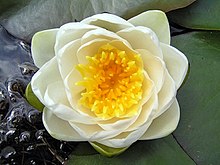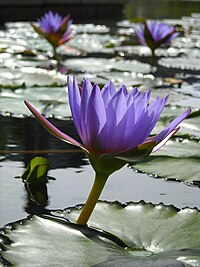Aquatic plants are plants that have adapted to living in aquatic environments (saltwater or freshwater). They are also referred to as hydrophytes or macrophytes. These plants require special adaptations for living submerged in water, or at the water's surface. The most common adaptation is aerenchyma, but floating leaves and finely dissected leaves are also common.nAquatic plants can only grow in water or in soil that is permanently saturated with water. They are therefore a common component of wetlands.

References

The flower of Nymphaea alba, a species of water lily.
The principal factor controlling the distribution of aquatic plants is the depth and duration of flooding. However, other factors may also control their distribution, abundance, and growth form, including nutrients, disturbance from waves, grazing, and salinity.
Aquatic vascular plants have originated on multiple occasions in different plant families; they can be ferns or angiosperms, including both monocots and dicots). Seaweeds are not vascular plants; rather they are multicellular marine algae and therefore are not typically included among aquatic plants. A few aquatic plants are able to survive in brackish, saline, and salt water. Examples are found in genera such as Thalassia and Zostera. Although most aquatic plants can reproduce by flowering and setting seed, many also have extensive asexual reproduction by means of rhizomes, turions, and fragments in general.
One of the largest aquatic plants in the world is the Amazon water lily, one of the smallest is the minute duckweed. Many small aquatic animals use plants like duckweed for a home, or for protection from predators, but areas with more vegetation are likely to have more predators. Some other familiar examples of aquatic plants might include floating heart, water lily, lotus and water hyacinth.
Some aquatic plants are used by humans as a food source. Examples include wild rice (Zizania), water caltrop (Trapa natans), Chinese water chestnut (Eleocharis dulcis), Indian lotus (Nelumbo nucifera), water spinach (Ipomoea aquatica) and watercress (Rorippa nasturtium-aquaticum).
Morphological Classification
The many possible classifications of aquatic plants are based upon morphology. One example has six groups as follows:
Water lilies grow rooted in the bottom with leaves that float on the water surface.
- Amphiphytes: plants that are adapted to live either submerged or on land
- Elodeids: stem plants that complete their entire lifecycle submerged, or with only their flowers above the waterline
- Isoetids : rosette plants that complete their entire lifecycle submerged
- Helophytes :plants rooted in the bottom, but with leaves above the waterline
- Nymphaeids: plants rooted in the bottom, but with leaves floating on the water surface
- Pleuston : vascular plants that float freely in the water
- ^ a b c d Sculthorpe, C. D. 1967. The Biology of Aquatic Vascular Plants. Reprinted 1985 Edward Arnold, by London.
- ^ a b Hutchinson, G. E. 1975. A Treatise on Limnology, Vol. 3, Limnological Botany. New York: John Wiley.
- ^ Cook, C.D.K. (ed). 1974. Water Plants of the World. Dr W Junk Publishers, The Hague. ISBN 90-6193-024-3.
- ^ a b Keddy, P.A. 2010. Wetland Ecology: Principles and Conservation (2nd edition). Cambridge University Press, Cambridge, UK. 497 p.
- ^ Tomlinson, P. B. 1986. The Botany of Mangroves. Cambridge, UK: Cambridge University Press.
- ^ Westlake, D.F., Kvĕt, J. and Szczepański, A. 1998. The Production Ecology of Wetlands. Cambridge University Press, Cambridge. 568 p.
External Links
- Wikipedia










No comments:
Post a Comment